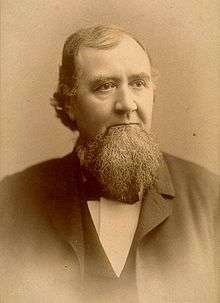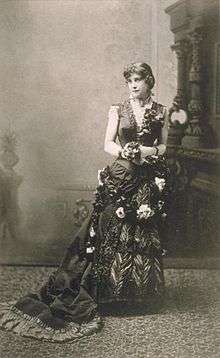David S. Terry
| David S. Terry | |
|---|---|
 | |
| 4th Chief Justice of California | |
|
In office 1857–1859 | |
| Preceded by | Hugh Murray |
| Succeeded by | Stephen J. Field |
| Personal details | |
| Born |
March 8, 1823 Russellville, Kentucky |
| Died |
August 14, 1889 (aged 66) Lathrop, California |
| Political party | Democratic |
| Spouse(s) |
Cornelia Runnels Sarah Althea Hill |
| Relations | Benjamin Franklin Terry (brother) |
| Profession | Attorney, politician |
| Military service | |
| Allegiance |
|
| Service/branch |
|
| Rank |
|
| Unit |
|
| Commands | 37th Texas Cavalry |
| Battles/wars | |
David Smith Terry (1823–1889) was a California jurist and Democratic politician, who was the Chief Justice of the Supreme Court of California,[1][2][3] and the primary author of the Constitution of 1879. He also won a duel with U.S. Senator David C. Broderick in Broderick's second duel in 1859. He died in 1889, after being shot by a bodyguard of U.S. Justice Stephen J. Field.
Biography
Terry was born in Todd County, Kentucky.[4][5] In 1831, his family moved and settled in Brazoria County, Texas until David Smith himself moved to California in 1849.[6] From 1855 to 1859 he was a California State Supreme Court Justice, serving as the 4th Chief Justice of California from 1857.
In 1856, the State of California declared San Francisco to be in a state of insurrection. Judge Terry travelled from Sacramento to San Francisco to negotiate, where he was kidnapped by armed gunmen, but he managed to stab one, Sterling A. Hopkins, a member of the San Francisco Committee of Vigilance, who was not tried.
A prominent incident in Terry's life came about when he took up the cause of the 'Widow Sanchez'. Maria Encarnacion Ortega de Sanchez, the widow of a wealthy rancher, was being cheated by local authorities, including the Sheriff, William Roach, who took her fortune under the guise of guardianship. After kidnapping Roach with the help of a local gunslinger named Anastacio Garcia, they held Roach in a jail cell in Stockton until he agreed to release the widow's gold. But Roach had bribed a guard to ride to Monterey and urge Roach's family to hide the gold. The treasure was hidden somewhere in Carmel Valley by Roach's brother-in-law, Jerry MacMahon. MacMahon was killed in a barroom brawl before he could reveal the location of the money. With no more gold left to the widow, Terry lost interest in her case.
Terry was a close friend of Democratic U.S. Senator from California David Broderick, he accused Broderick, a Free Soil advocate, of having engineered his loss for re-election in the 1859 state elections. Terry issued inflammatory comments at a state convention in Sacramento, which offended Broderick.
On September 13, 1859, Terry and Broderick, having agreed to a duel, met just outside San Francisco city limits. Terry won the coin toss to select weapons, and chose pistols that had hair triggers. Broderick's discharged early, leaving him open for Terry's shot. At first Terry thought that he had only wounded Broderick, but the senator died three days later.
Although Terry was acquitted of murder he left the state. He fought during the American Civil War, serving in the 8th Texas Cavalry Regiment of the Confederate States Army. This unit was raised by his brother Benjamin Franklin Terry and was also known as Terry's Texas Rangers. David Terry later became Colonel of the 37th Texas Cavalry Regiment and was wounded at the Battle of Chickamauga. He came back to California in 1868 after the war was over, and while a delegate to the Constitutional Convention, his Progressive plan was adopted.
Marriage

Terry became entangled in a mysterious divorce case in the 1880s. A young woman named Sarah Althea Hill claimed that she was the legal wife of silver millionaire William Sharon. Sharon denied that they had ever married, but Hill wanted a divorce and a share of Sharon's treasure. She lost her case and eventually wound up marrying Terry.
Downfall and death
On behalf of his wife, Terry appealed the ruling on his lawsuit against silver millionaire William Sharon. United States Supreme Court Justice Stephen J. Field, a former friend of Broderick's, heard the case in 1888 as the senior justice of the Federal circuit court in California. Field ruled against Mr. and Mrs. Terry in a final appeal, and jailed them both on contempt of court. The Terrys vowed vengeance.
A year later, on August 14, 1889, David Terry assaulted Field at a train station in Lathrop, near Stockton, California. Field's bodyguard United States Marshal David Neagle (formerly assigned to Tombstone, Arizona) shot and killed Terry. Neagle was arrested by California authorities on a charge of murder. The United States secured the release of Neagle on a writ of habeas corpus. The issue was resolved by In re Neagle, 135 U.S. 1 (1890), a United States Supreme Court decision that determined that the Attorney General of the United States had authority to appoint U.S. Marshals as bodyguards to Supreme Court Justices, and that Federal appointments superseded State law regarding conduct of bodyguards.
David S. Terry is buried at Stockton Rural Cemetery in Stockton.
His wife, Sarah Terry became insane, and spent the rest of her life at the Stockton State Hospital for the insane, where she died in 1936. She is buried in the same gravesite as her husband. Terry's first wife, Cornelia Runnels, is buried next to him.
References
- ↑ "Journal - State Bar of California, Volume 22". State Bar of California. 1947. Retrieved January 14, 2016.
- ↑ "Journal: Appendix. Reports - Volume 8". California Legislature. 1887. Retrieved January 14, 2016.
- ↑ Lawson, Kristan; Rufus, Anneli (2013). California Babylon. St. Martin's Press. p. 196. ISBN 1466854146. Retrieved January 14, 2016.
- ↑ Shuck, Oscar Tully (1889). "Bench and Bar in California: History, Anecdotes, Reminiscences". Occident Printing. p. 281. Retrieved January 14, 2016.
- ↑ "ABA Journal". 43 (5). ABA Journal. May 1957: 416. Retrieved January 14, 2016.
- ↑ Fullmore, Zachary Taylor (1915). "The History and Geography of Texas as Told in County Names". E. L. Steck Press. p. 259. Retrieved January 14, 2016.
No reliable references
- Kirchner, Paul (2010), Bowie Knife Fights, Fighters, and Fighting Techniques, Boulder, Colorado: Paladin Press, ISBN 1-58160-742-3
External links
- David Smith Terry at Handbook of Texas Online
- David S. Terry at Find a Grave
| Legal offices | ||
|---|---|---|
| Preceded by Hugh C. Murray |
Chief Justice of California 1857–1859 |
Succeeded by Stephen J. Field |
